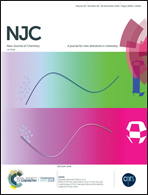Conjugated microporous polymer nanosheets and nanotubes as novel absorbents for microcystin-LR: insights from theoretical investigations
Abstract
To solve the widespread problem of harmful cyanobacterial toxins, developing novel and effective porous adsorbents is one key solution. This paper discusses the possibility and reliability of using conjugated microporous polymer (CMP) materials as adsorbents for the removal of microcystin. The noncovalent interactions of microcystin-LR (MC-LR) with CMP nanosheets and nanotubes were investigated using a density-functional tight-binding method with an empirical van der Waals force correction. We show that the microcystin-LR molecule could be spontaneously adsorbed onto the CMP surface at physisorption distances. The competition of these weak π–π and H–π interactions determines the final equilibrium structures and binding energies. The flexible MC-LR tends to deform to maximize the interaction with CMP, while the geometric and electronic structures of CMP nanostructures basically remain undamaged upon the MC-LR adsorption. This paper provided a quantum mechanical level understanding of some fundamental aspects of the MC-LR/CMP interactions, including the physisorption mechanism, electronic structures and binding energies. Our calculations demonstrated that the CMP materials could be developed as possible adsorbents for MC-LR adsorption/removal.



 Please wait while we load your content...
Please wait while we load your content...